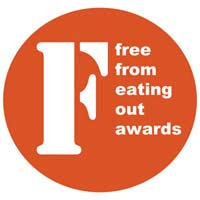Gluten-free living for children
Our daughter was diagnosed as coeliac over 10 years ago, when she was nearly 2. Since then, we’ve learnt a great deal about living gluten-free, much of it from other people in the same situation. I used to run the children’s section of the local coeliac group, and I learned a great deal from talking to the other parents.
There are certain special issues that face children in managing their gluten-free life. These include:
- nurseries and other childcare
- birthday parties – their own and other peoples
- tea at friends houses – or sleepovers, as they get bigger
- school
- cubs, brownies and other group activities.
You will be worried about their health as they grow up – and every tummy pain or other symptom will be met with “Have you eaten something you shouldn’t?”, even though coeliac children get tummy bugs too. Not everything is due to needing a gluten-free diet!
Things that might worry you include:
- will my child catch up on missed growth?
- what tests should my child have?
- should all of us adopt the same special diet?
- are my other children going to have the same problem?
- are we ever going to be able to eat out as a family?
I can’t claim to have all the answers, and every child is different, but this is what we found, and how we manage.
Nurseries and other childcare
My daughter went part-time to a day nursery, and we provided much of her food. I took in her bread, which could be kept frozen in their freezer, and defrosted a slice at a time for breakfasts. You could also consider providing packets of gluten-free cereal, as well. She ate the meals provided by nursery when they were OK for her to eat; I went through the menus with the cook to talk about what would and what wouldn’t be OK. If the meal wasn’t going to be free from gluten, I took in frozen food which could be defrosted as needed. In those days, there wasn’t so much available, and I spent time making gluten-free fish fingers, chicken nuggets and ‘tinned spaghetti’, so that her food looked as much like the others as possible. All these things are now available at supermarkets.
As for schools, it is the unusual events that will catch you out – parties, treats and outings. You will always need to double-check that they have remembered, and will often need to send supplies for your child.
Birthday Parties, School Parties and Discos
My daughter always takes her own party food with her. I discuss it with the hostess of the party, and try to come up with something that looks as much as possible like what the other children are eating. I used to make miniature birthday cakes for her to take along as well – but I found that they weren’t ever eaten, so I gave up!
Of course, if it is your own child’s party, then you can easily make the whole meal free from gluten, and their guests will never notice. If you are worried that a small guest may say “Yuck!” about the bread, for instance, and upset your child, you could make two types of sandwiches, and tell your child which are OK.
Party bags are a problem – you can hardly ask someone to make up a special party bag for your child. I make sure that nothing is eaten until I have checked whether it is OK or not, and have substitutes available. I have found that my children will always share party bags with their siblings, saying things like “this is OK, so you can have this one …” “this isn’t, so he can have that one …”. Your child will become familiar with what sweets are OK, and which are not.
Tea and Sleepovers
Your child’s best friend’s parents may become nearly as familiar with what is acceptable and what isn’t as you do. If you are lucky, they will remember, and will provide a naturally gluten-free meal for your child. I always check – it is difficult for a child to refuse food, particularly if pressed, as it will seem impolite.
I always check, and always offer to send supplies of special bread, pasta, flour – whatever seems appropriate.
School Dinners or Packed Lunches
This will vary enormously by school. Some schools seem only to offer dinners, and don’t allow packed lunches; others are the other way around. Some school catering teams are very enthusiastic about the challenge of providing gluten-free meals; others don’t want the responsibility. Some invite you to send in food for them to reheat. It is our understanding that schools are obliged to provide food for special diets if you request it – but you would need to check. We recommend talking to the Head and to the catering staff – and maybe the school governors as well.
We send our daughter in with a packed lunch, because at her school, they would only arrange a meal to be sent in from some central department, with no guarantee that it would be at all similar to what the others were eating that day. We decided that since she was different enough already, this would only emphasise the difference, and so many people eat packed lunches, that she wouldn’t look too different.
Treats from Teachers
Some teachers like to offer sweets, either as regular treats for good behaviour or work, or as gifts at Christmas or for birthdays. I don’t have a problem with this, but always talk to the teacher at the beginning of the year, and send in a pack of gluten-free sweets for them to have to offer my daughter.
Baking and other activities
This will depend on the age of your child. Be aware that play-dough is not gluten-free, and nor are some glues. You can make gluten-free play-dough if necessary. Children may do baking at nursery or school – this is clearly a contamination risk. You could send in special flour (don’t forget to send gluten-free baking powder as well), and you will need to check the other ingredients, e.g. writing icing for decorating biscuits may not be free from gluten.
Food swopping
We have never had a problem with this, though I can imagine that it does happen, and that some children find it difficult to resist. The gluten-free foods are often packaged in a very ‘worthy’ pack, appealing to an adult idea of health, and a brightly coloured pack, perhaps with one of your child’s favourite TV character on, may be very tempting.
All you can do is explain to your child that someone else’s food may make them poorly. Good luck with this one.
School Trips
Again, you will need to discuss this with the teachers. I always send packed lunches for these trips, but I have been caught out when one of the activities was ‘cooking in the victorian kitchen’ – which involved kneading bread. Make sure that hands get thoroughly washed!
Cubs, Brownies and other group activities
As for school, discuss this with the adults in charge. It is perfectly possible for your child to join in almost all activities with very minimal change. My daughter has successfully been away on a Brownie camp for a weekend without any issue with gluten.
Will my child catch up on missed growth?
Ask your doctor. This will depend on how long your child went undiagnosed, and at what stage, and it is of course difficult to know how tall your child would have grown if they hadn’t had a malnutrition problem.
What tests should my child have?
This seems to vary by area. My daughter has an annual meeting with her paediatrician, an annual blood test, and an annual bone-age scan. The blood tests check whether everything is working normally, and whether any gluten is sneaking into her system. The bone-age scan is to check whether she is catching up on her growth.
Should all of us adopt the same special diet?
You could, because it would do you no harm, and is usually a very healthy diet – but this would be very expensive.
Are my other children going to have the same problem?
Not necessarily, but they might. If you are worried, have them checked (and yourself). And don’t forget, even if you’ve been checked once, and the results were negative, you might develop the problem later.
Are we ever going to be able to eat out as a family?
Yes you are! With a bit of planning, perhaps phoning ahead if you’re not sure, this can be done. Your child won’t have the same choice as everybody else, but they won’t go hungry. It is often easier for our daughter to choose from the adult menu, as a children’s menu is always wheat-based (pizza, nuggets, sausages).
You can take your own food to some places – though beware of cross-contamination. For instance, McDonald’s will put one of their gluten-free burgers into one of our bread rolls. But some pizza ovens are laden with semolina (which is derived from wheat) to stop the pizzas from sticking – be careful where you take your pizza base.
The excitement of finding a place where the menu is marked up as to what is gluten-free, so that we don’t have to discuss it yet again, is quite absurd – and we have decided to stop and eat at places we were passing which advertised their gluten-free food in the window or on the menu, even when we weren’t ready to eat yet.
Note: ‘Celiac’ and ‘coeliac’ mean the same – one is an American spelling, and the other is British. We aim to use both, but we recognise that there are many reasons to need a gluten-free diet, and we don’t intend to exclude anyone by using ‘celiac’ or ‘coeliac’.

